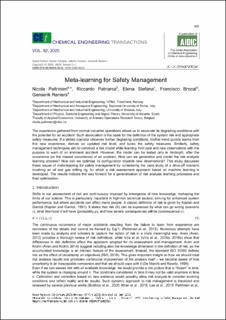| dc.contributor.author | Paltrinieri, Nicola | |
| dc.contributor.author | Patriarca, Riccardo | |
| dc.contributor.author | Stefana, Elena | |
| dc.contributor.author | Brocal, Francisco | |
| dc.contributor.author | Reniers, Genserik | |
| dc.date.accessioned | 2022-05-03T14:27:19Z | |
| dc.date.available | 2022-05-03T14:27:19Z | |
| dc.date.created | 2020-12-08T14:15:57Z | |
| dc.date.issued | 2020 | |
| dc.identifier.citation | Chemical Engineering Transactions. 2020, 82 169-174. | en_US |
| dc.identifier.issn | 1974-9791 | |
| dc.identifier.uri | https://hdl.handle.net/11250/2994002 | |
| dc.description.abstract | The experience gathered from normal industrial operations allows us to associate its degrading conditions with the potential for an accident. Such association is the basis for the definition of the system risk and appropriate safety measures. If a skilled operator observes further degrading conditions, his/her mind quickly learns from this new experience, derives an updated risk level, and tunes the safety measures. Similarly, safety management techniques aim to construct a risk model while learning from past and new observations with the purpose to warn of an imminent accident. However, the model can be tested only in hindsight, after the occurrence (or the missed occurrence) of an accident. How can we generalise and model the risk analysis learning process? How can we optimise its configuration towards new observations? This study discusses these issues of meta-learning for safety management by considering the case study of a drive-off scenario involving an oil and gas drilling rig, for which a risk assessment approach based on machine learning is developed. The results indicate the way forward for a generalisation of risk analysis learning processes and their optimisation | en_US |
| dc.language.iso | eng | en_US |
| dc.publisher | The Italian Association of Chemical Engineering (AIDIC) | en_US |
| dc.rights | Navngivelse 4.0 Internasjonal | * |
| dc.rights.uri | http://creativecommons.org/licenses/by/4.0/deed.no | * |
| dc.title | Meta-learning for Safety Management | en_US |
| dc.title.alternative | Meta-learning for Safety Management | en_US |
| dc.type | Peer reviewed | en_US |
| dc.type | Journal article | en_US |
| dc.description.version | publishedVersion | en_US |
| dc.source.pagenumber | 169-174 | en_US |
| dc.source.volume | 82 | en_US |
| dc.source.journal | Chemical Engineering Transactions | en_US |
| dc.identifier.doi | 10.3303/CET2082029 | |
| dc.identifier.cristin | 1857511 | |
| cristin.ispublished | true | |
| cristin.fulltext | original | |
| cristin.qualitycode | 1 | |

